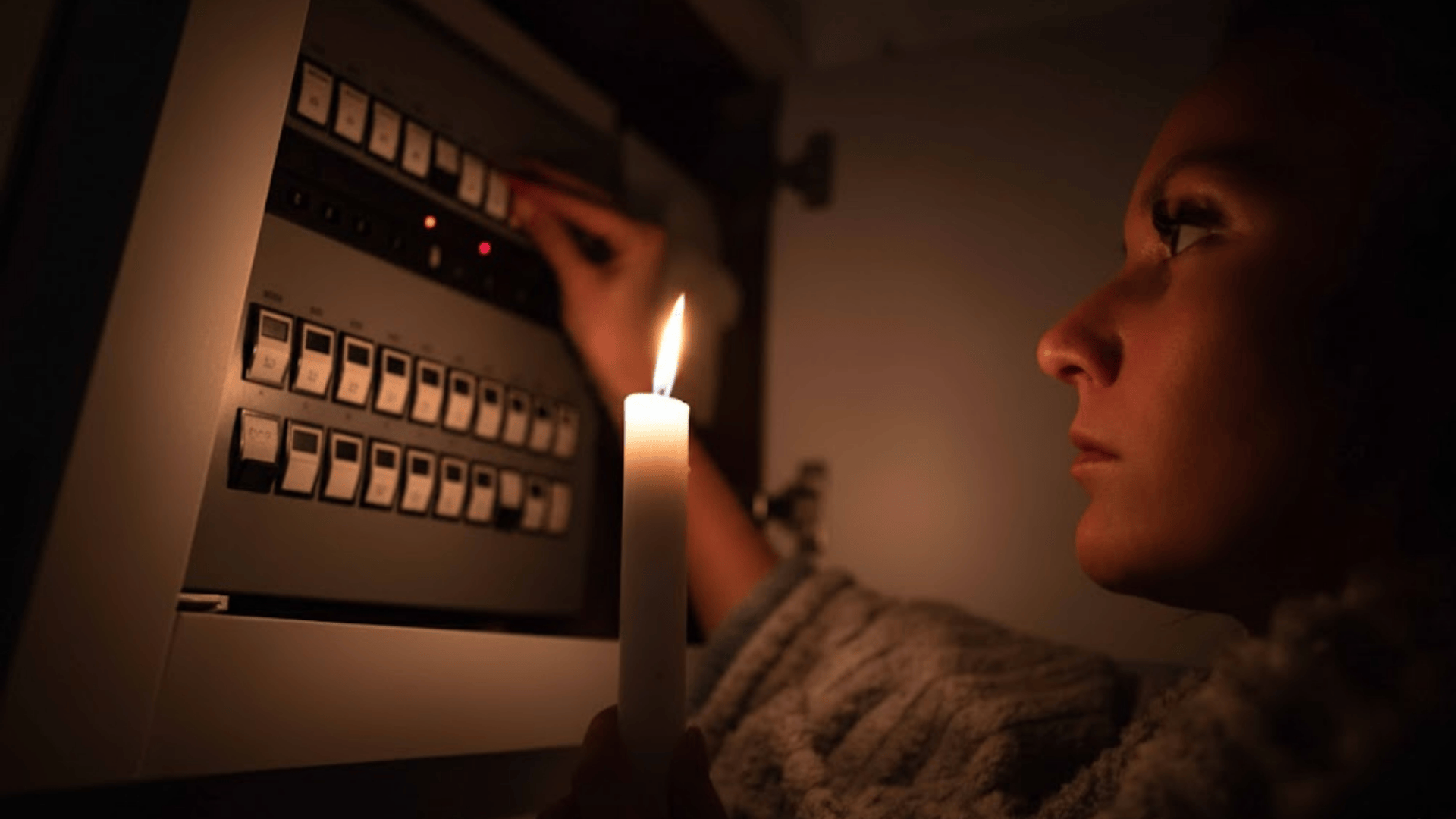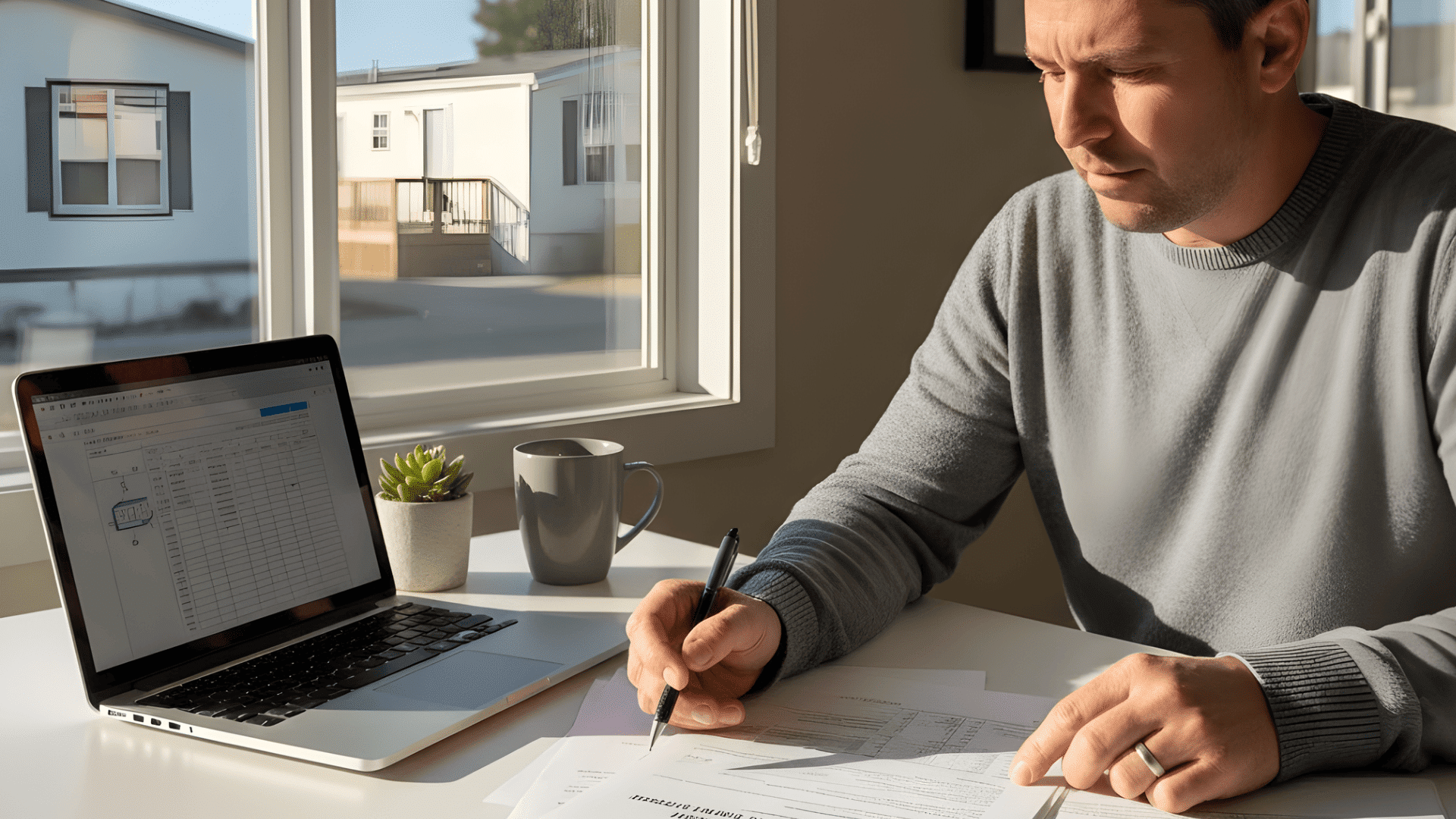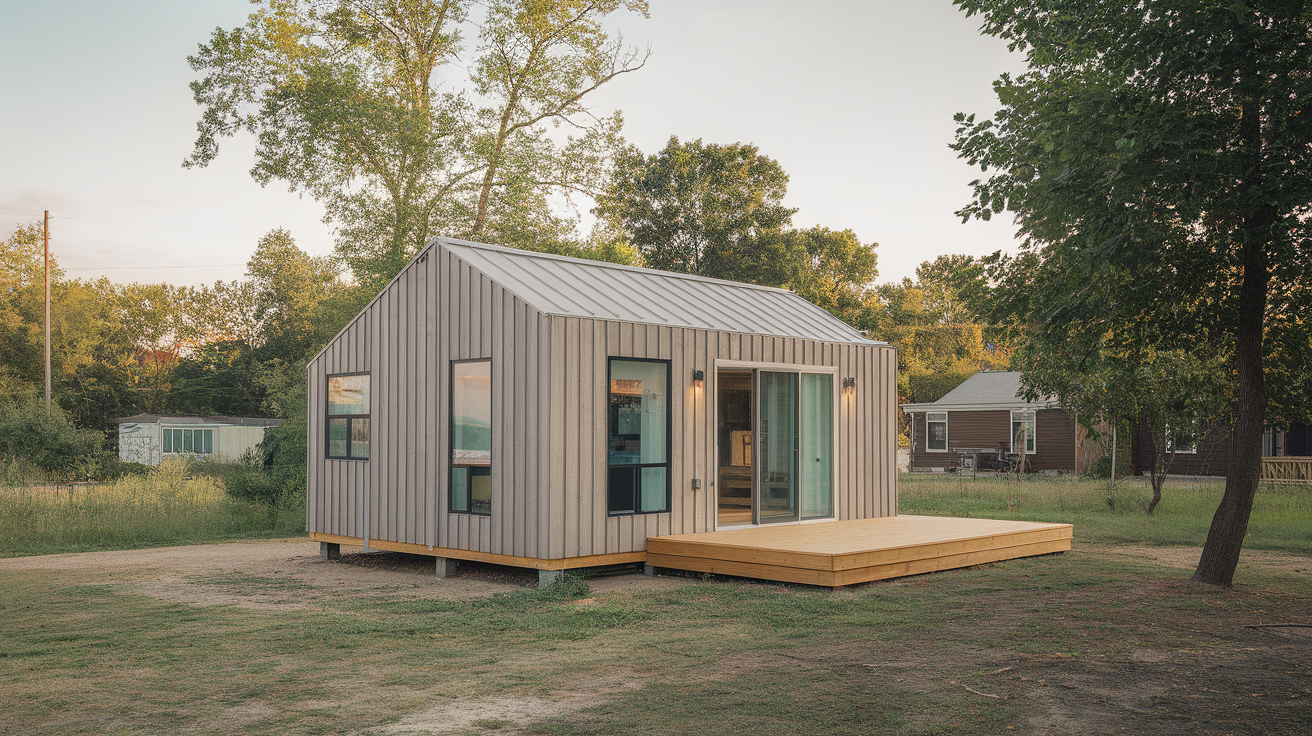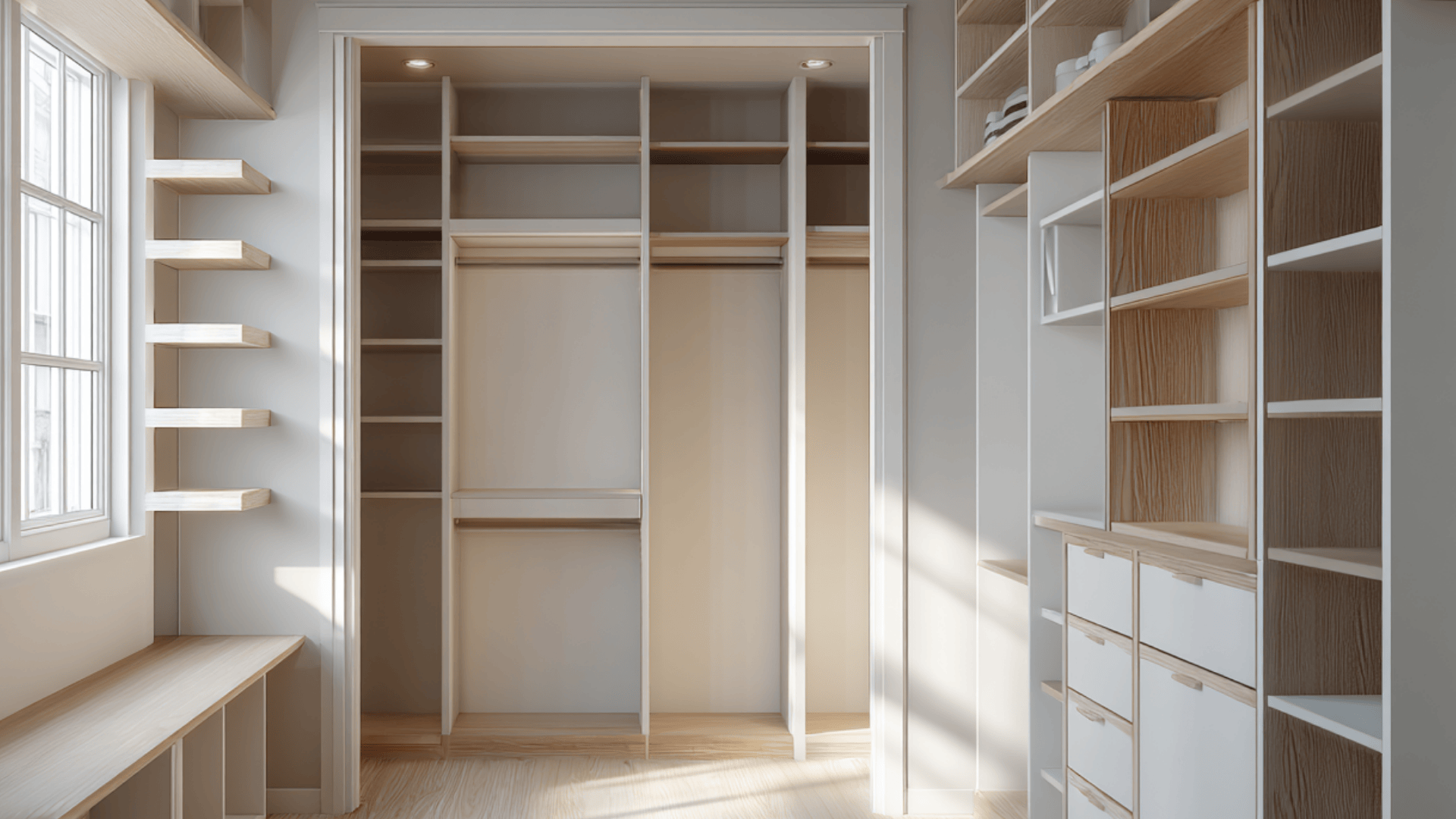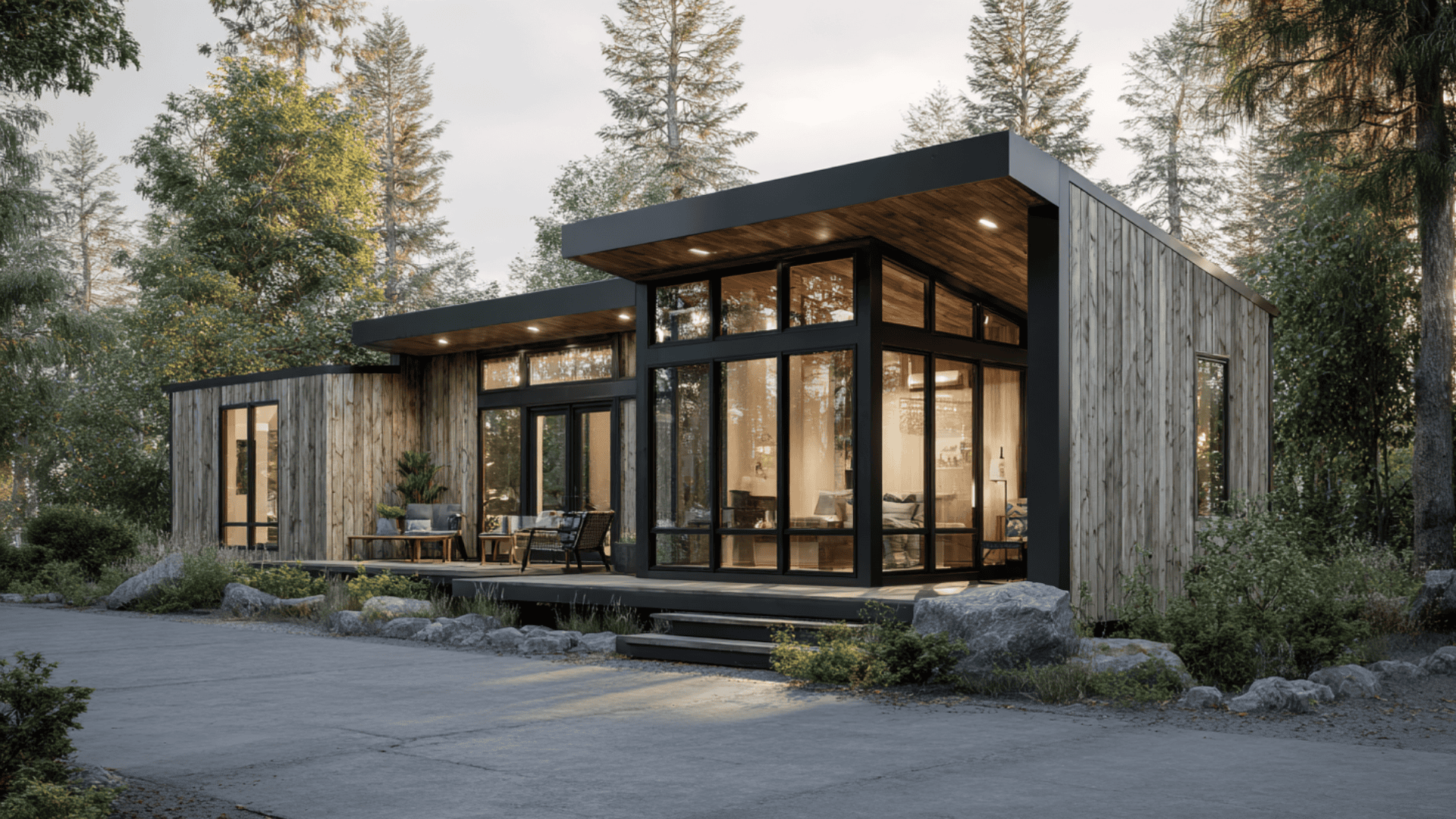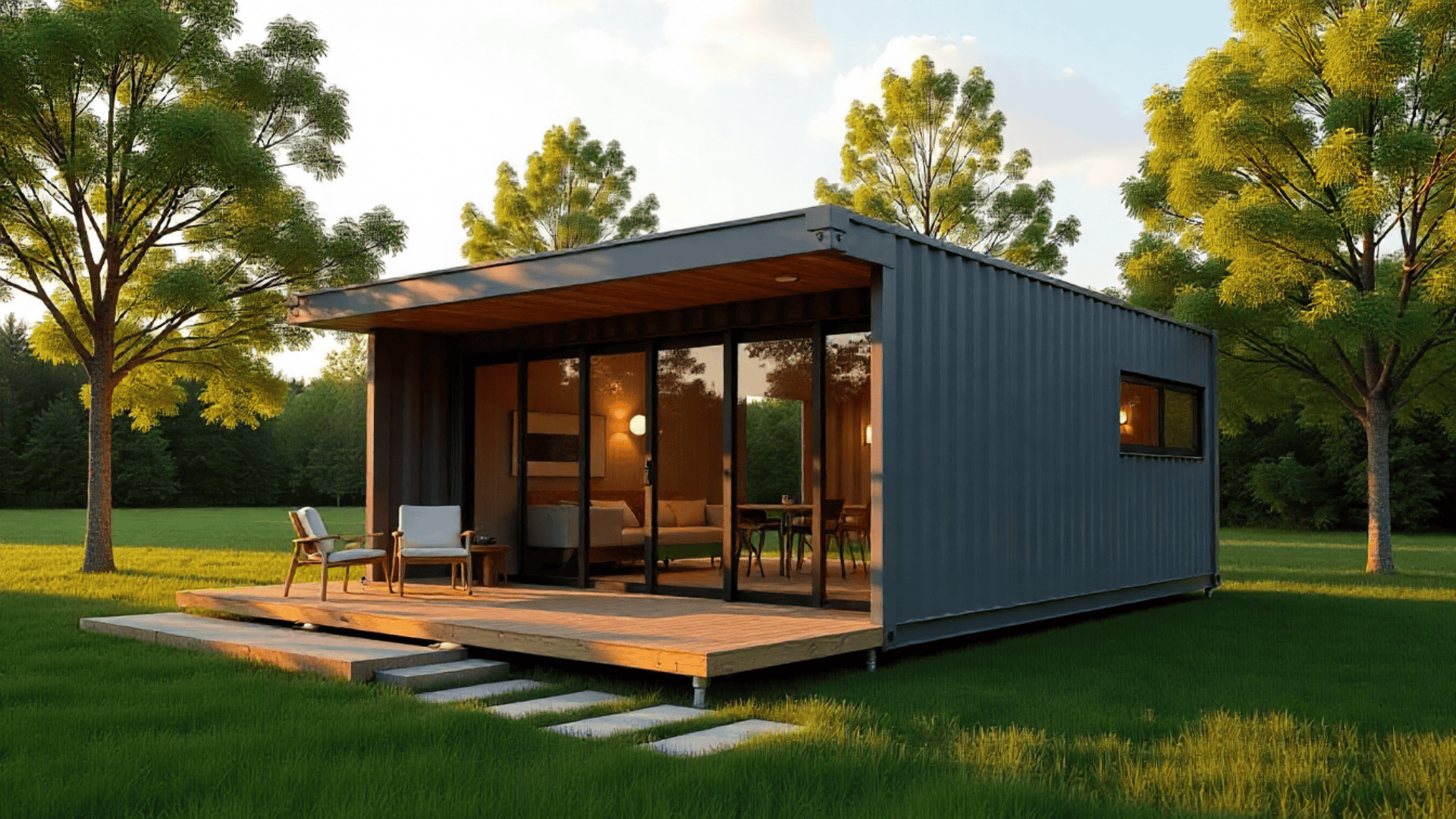When the lights suddenly go out, it’s normal to pause and think, “What now?” Maybe you’re in the middle of cooking, the kids are nervous, your phone battery is low, and you’re hoping it’s not a long night.
This guide walks you through what to do when power goes out in a simple, calm way. You’ll get clear steps for how to keep and stay safe during both short and long outages, without losing hope.
I’ll also touch on a bit of prep so you’re not caught off guard next time, just real-world tips you can actually use when everything goes dark.
Understanding the Basics of Power Outages
Power cuts don’t happen by magic. They usually come down to a few simple reasons, and they affect more than just your lights.
Why does the power go out?
Power usually goes out when something breaks the flow of electricity, such as:
- Bad weather: storms, ice, snow, strong winds, heatwaves, damaging lines and equipment
- Overloaded grid: very hot or very cold days when many people use AC or heating at once
- Equipment or accidents: old parts failing, trees falling, or cars hitting poles
- Planned shutoffs: the utility turning power off on purpose to prevent wildfires or do repairs
How long can a power cut last?
- A few seconds (lights flicker and come back)
- A few hours (local problem being fixed)
- 1–3 days or more after big storms or major damage
Why do power cuts cause other problems?
When the power goes out, other things can stop working too:
- Wi-Fi and cell service can weaken or fail
- Water systems or well pumps may stop
- Gas stations, ATMs, and stores may close or not work properly
That’s why a power outage, especially during storms or extreme weather, can quickly make life harder, not just darker.
What to Do When the Power Goes Out: The First 5 Minutes
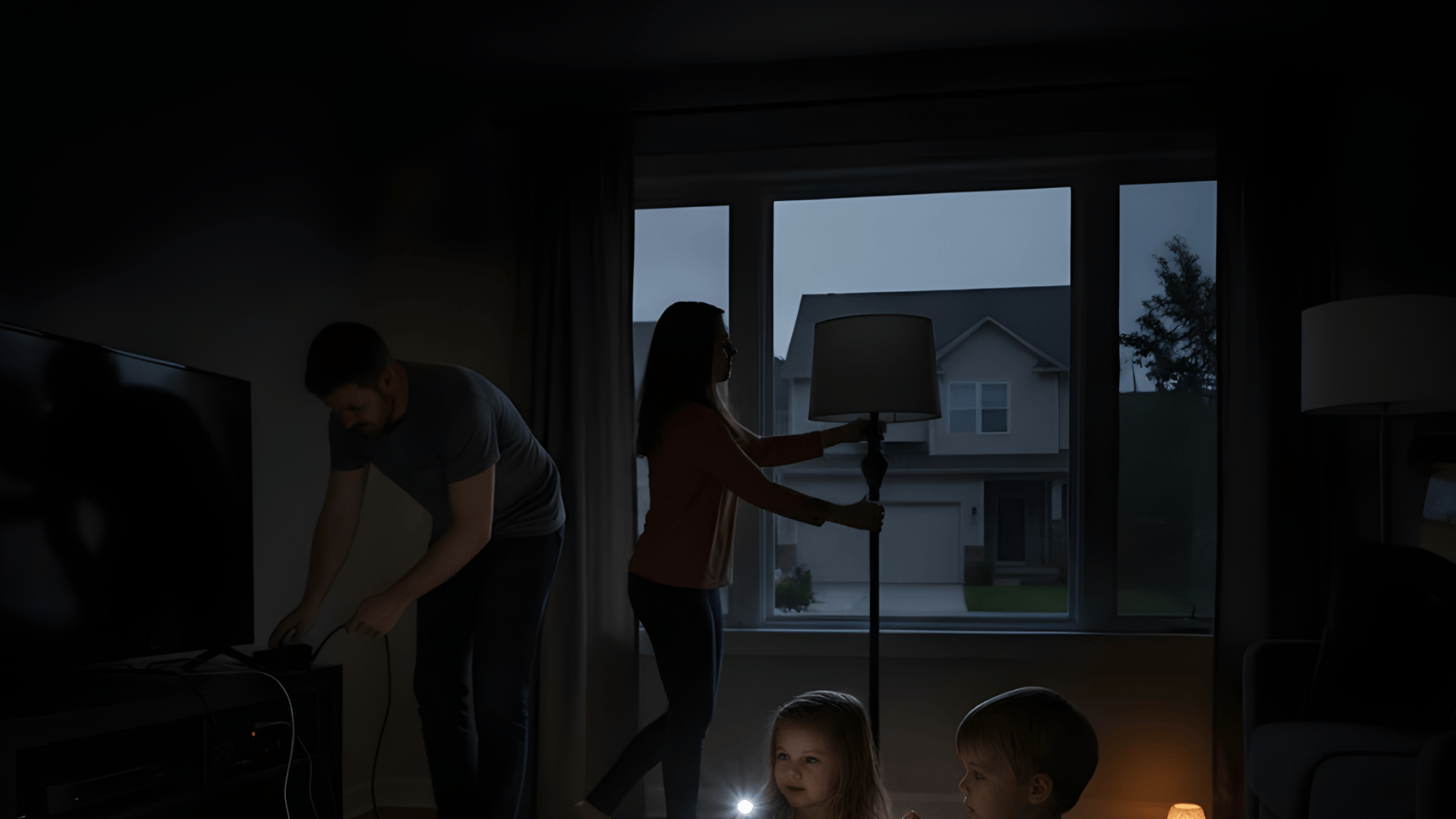
The first few minutes after a power cut are all about safety and simple, quick actions. If you handle this part calmly, the rest of the outage will be much easier to manage.
1. Stay Calm and Check for Danger
Take a breath and try to stay calm. Turn on a safe light like a flashlight, headlamp, or your phone light so you’re not moving in the dark. Now quickly scan for danger. Look and smell for:
- Fire or sparks
- Burning or melted plastic smell
- Water near plugs, wires, or the breaker panel
Make sure kids, older adults, and pets are okay. If you see or smell anything unsafe, leave the home right away and call emergency services from a safe place.
2. Check if It’s Just Your Home or The Whole Area
Next, see how big the outage is. Look outside and check if streetlights and neighbors’ homes are also dark.
If only your home is out, the problem might be with your breaker or wiring, which you can check later when it’s safe. If many homes are dark, it’s likely a bigger outage, so expect the power may be out for longer.
3. Turn Off Big and Sensitive Appliances
Once everyone is safe, the next step is to protect your appliances and electronics. When the power comes back, there can be a surge that might damage them, so it’s good to switch a few things off, especially big and sensitive appliances:
- Heaters and AC units
- Ovens and stoves
- TVs and sound systems
- Gaming consoles
- Desktop computers
After that, leave one small lamp or light switched on. This way, you’ll know the moment the power comes back on without turning everything else on at once
4. Use Safe Lights Only
Choose safe lighting during a power cut. Use flashlights, headlamps, or battery lanterns as your first choice.
Avoid candles if you can. If you must use them, place them in sturdy holders on a flat surface and keep them away from curtains, paper, and bedding.
Never leave candles unattended or where kids and pets can reach them.
What to Do During an Outage

Once the power has been out for a while, your focus shifts to staying safe and comfortable. These tips help you get through 1–3 days without power without creating new problems:
1. Avoid Electrical Dangers
Electricity can be dangerous even when the power is out. Treat anything with wires or lines with extra care:
- Stay away from any downed wires.
- Call the utility or 911 to report them.
- Don’t stand in water near plugs, cords, or the breaker panel.
- Avoid elevators when the power is unstable or flickering.
2. Avoid Carbon Monoxide Poisoning
CO is a silent killer, so anything that burns fuel needs extra caution:
- Never run a generator inside the house, in the garage, or near windows or doors.
- Don’t use gas stoves, ovens, or grills to heat your home.
- Use CO detectors with batteries and test them if you can.
3. Keep Food Safe
Food safety becomes a real issue in longer outages. A few simple rules can help you avoid getting sick:
- Keep fridge and freezer doors closed as much as possible.
- The freezer can stay cold for about 24–48 hours if you keep it shut.
- Fridge food is unsafe after about 4 hours without cooling.
- If you’re not sure food is safe, throw it out. Your health is more important.
4. Staying Warm in Winter
Cold weather outages can be tough, but you can stay warmer with a few tricks.
- Close doors to rooms you’re not using.
- Stay together in one “warm room” if you can.
- Wear layers, socks, and hats; use blankets or sleeping bags.
- Only use fireplaces or wood stoves if you know they are safe and properly vented.
5. Staying Cool in Summer
In a heatwave, staying cool is just as important as staying warm in winter:
- Drink water often and avoid alcohol or heavy meals.
- Take cool showers, use wet cloths, and stay in the shade.
- Go to cooling centers or public places with AC if your home is too hot.
6. Water, Hygiene, and Toilets
Staying clean and managing water well keeps everyone healthier and more comfortable:
- If you use a well, expect to lose water when the power is out.
- Use stored water wisely and don’t waste it.
- For hygiene, use hand sanitizer and wet wipes when water is limited.
- Have a simple backup toilet option ready, like a lined bucket if needed.
7. Keeping Minds (and Pets) Calm
Power cuts are stressful, especially for kids and animals. A bit of comfort and distraction goes a long way:
- Keep kids busy with games, drawing, stories, or simple tasks.
- Use comfort items like favorite toys, books, or blankets.
- For pets, make sure they have food, water, a safe place to rest, a leash or crate, and ID tags.
These steps help you ride out a longer outage without panic. If you stay safe, warm or cool, fed, and calm, you’re already handling the situation well.
Who and When to Call?
Once you’ve handled the basic safety steps, the next question is who should step in to help. You don’t need to fix everything yourself, but you do need to call the right person for the right problem.
Call the Power Company
Call your power company when the outage affects more than just your home. If many houses on your street are dark or streetlights are off, it’s likely a wider outage.
You can also call them if you checked your breaker and everything looks normal, but you still have no power. Use their phone number, website, or app to report the outage and check updates.
The power company handles lines, poles, and the grid outside your house.
Call an Electrician
Call a licensed electrician when the problem seems to be inside your home. This includes cases where only your home is out, only some rooms have power, or your breaker keeps tripping.
You should also call an electrician if outlets look burned, smell odd, or the breaker panel is buzzing or hot. Don’t keep flipping breakers if they keep tripping or if something seems wrong.
Call 911 or Emergency Services
Call 911 only when there is real danger. This includes fire, smoke, someone getting an electric shock, or a power line on a house, car, road, or the ground.
A strong gas smell is also a reason to call 911 right away. In any of these cases, treat it as an emergency and call immediately.
Before It Happens: Getting Ready for a Power Cut
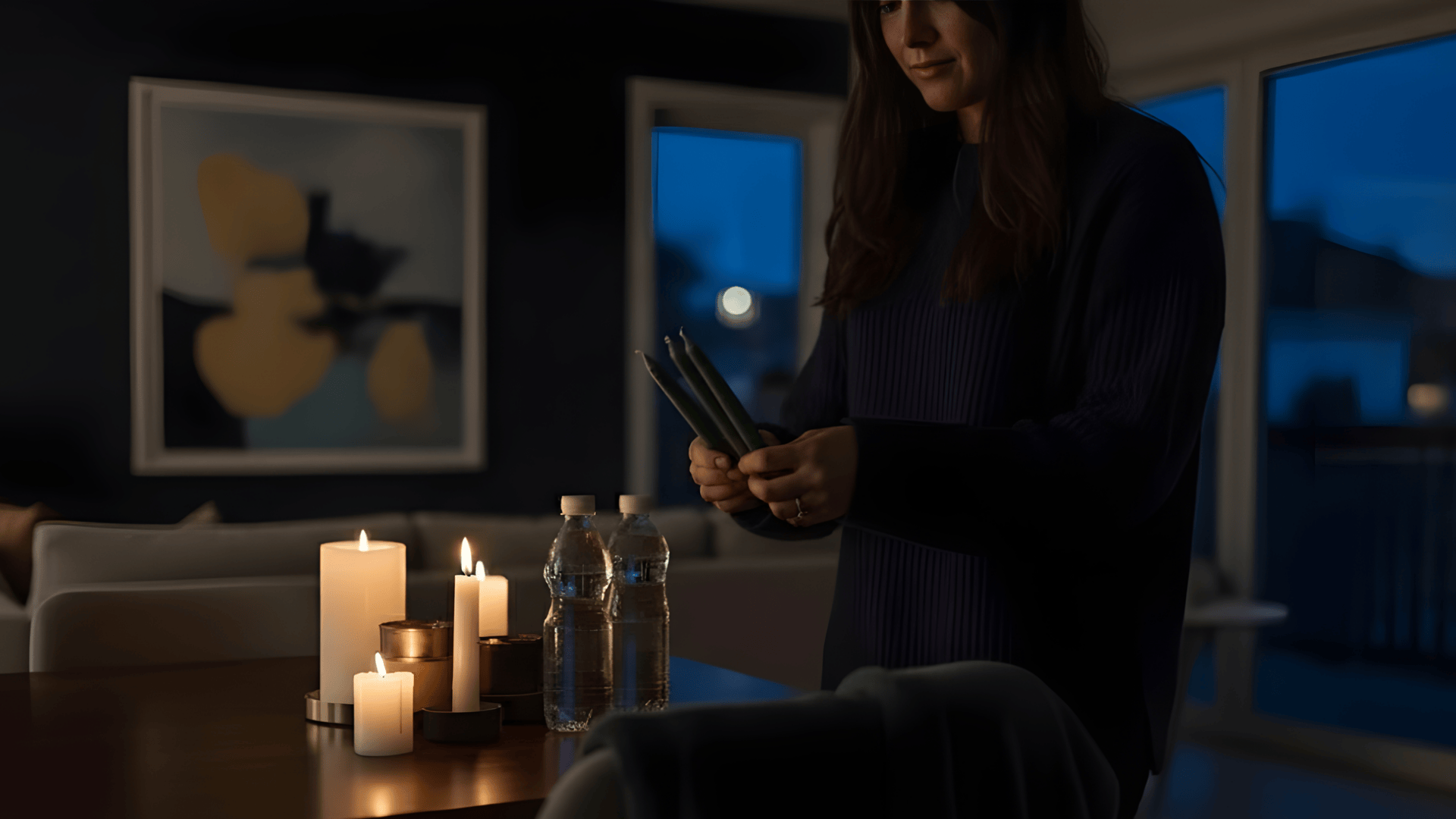
It’s much easier to handle a power outage when you’re ready before it happens. A few simple steps now can save you a lot of stress later.
1. Make a Simple Power Outage Kit
Think of this as your “lights are out, but we’re okay” kit. Keep it in one easy-to-reach spot so you’re not hunting in the dark:
- Flashlights and headlamps
- Extra batteries and power banks
- Battery or crank radio
- First aid kit
- Bottled water and easy, non-perishable food
- Manual can opener
- Basic tools and duct tape
2. Extra Power Gear
A few extra items can help keep your devices working and protect them from damage. These are simple add-ons that make a big difference in a long outage:
- Surge protectors
- Phone chargers and power banks
- Battery lanterns (safer than candles)
- Optional: UPS for your Wi-Fi or computer
- Optional: portable power station or generator (used safely, outside only)
3. Plan for Health and Special Needs
If anyone in your home relies on power for health reasons, planning ahead is critical. Think about what they need and how you’ll manage if power is out for a long time:
- Make a list of anyone who needs power for wheelchairs, oxygen, and other medical devices.
- Plan backup power options and where you can go if power is out for too long
- Ask your utility or city if they have programs for people with medical needs.
4. Protect Food and Water in Advance
You can keep food safe longer if you prepare your fridge, freezer, and water supply ahead of time.
These small habits help a lot when the power suddenly cuts:
- Keep the fridge and freezer neat so air can move
- Use thermometers inside the fridge and freezer
- Make ice blocks or freeze water bottles before big storms
- Store extra water: about 1 gallon per person per day for at least 3 days
5. Simple Family Plan for a Power Cut
Everyone in the house should know what to do when the lights go out. A quick plan keeps things calm and organized:
- Decide who will, check the breaker, call the utility, and check on neighbors if safe.
- Choose a meeting spot if you must leave the home.
- Keep an emergency contact list printed and saved offline.
These small steps don’t take much time, but they make a huge difference when the power actually goes out. If you prepare now, you’ll feel safer, calmer, and far more in control during a power cut.
Special Cases: Adjusting Your Plan
Some homes need a slightly different plan during a power cut. Where you live and who you live with can change what matters most.
| Situation | What to Keep in Mind | Key Actions to Take |
|---|---|---|
| Apartments and high-rise buildings | Elevators may stop, and higher floors can have water issues | Plan to use stairs if elevators don’t work; know where emergency exits are; be aware that water pressure may drop on higher floors |
| Rural homes with wells and septic systems | Wells and pumps need power, and septic issues can be harder to fix | Store more water than city homes usually need; consider a generator mainly for the well pump and fridge |
| Higher-risk people (disability, illness, seniors alone) | Power loss can affect health and safety more quickly | Keep backup chargers for medical devices; know where accessible shelters or safe places are; set regular check-ins with neighbors or family; plan for storing and refilling important medicines |
These small tweaks help make your outage plan safer and more realistic for your situation. Think through which row best fits you, and adjust your checklist accordingly.
After the Power Comes Back
When the lights come back on, don’t rush back to “normal” right away. These steps help you restart safely and fix anything the outage might have damaged:
- Turn things back on slowly: When power returns, don’t flip everything on at once. Turn big appliances like the fridge, freezer, and heating or cooling on one by one. Then reset clocks, thermostats, Wi-Fi, and alarms.
- Check food, medicine, and water: Check what stayed cold and what didn’t. Throw out any food or medicine that may have been warm too long or that seems unsafe. Use thermometer readings if you have them.
- Look for damage: burn marks on outlets, strange smells, or breakers that keep tripping. If the outage came with a storm, also check the roof, siding, and basement. Call a pro if anything looks unsafe.
- Sort out the money and help: Take photos and make a list of damaged items for insurance. Check if there are local relief centers, community groups, or aid programs that can help if you have had big losses.
- Improve your plan for next time: Note what worked and what didn’t during the outage. Add missing items to your kit and fix any gaps in your plan. Set a reminder to review your outage prep every 6–12 months.
If you check, fix, and improve a little each time, every future power cut will be easier to handle.
Wrapping Up
When power goes out unexpectedly, knowing what to do can make all the difference. A power outage isn’t just about losing light; it’s about staying safe, keeping calm, and protecting what matters most.
Taking a few minutes now to prepare a kit, learn who to call, and understand how to handle short or long blackouts can save hours of stress later. Every outage is easier when you plan ahead, stay alert, and adapt as needed.
Start building your simple outage plan today. Because a little preparation now can keep your home, family, and peace of mind secure when the lights go out.

